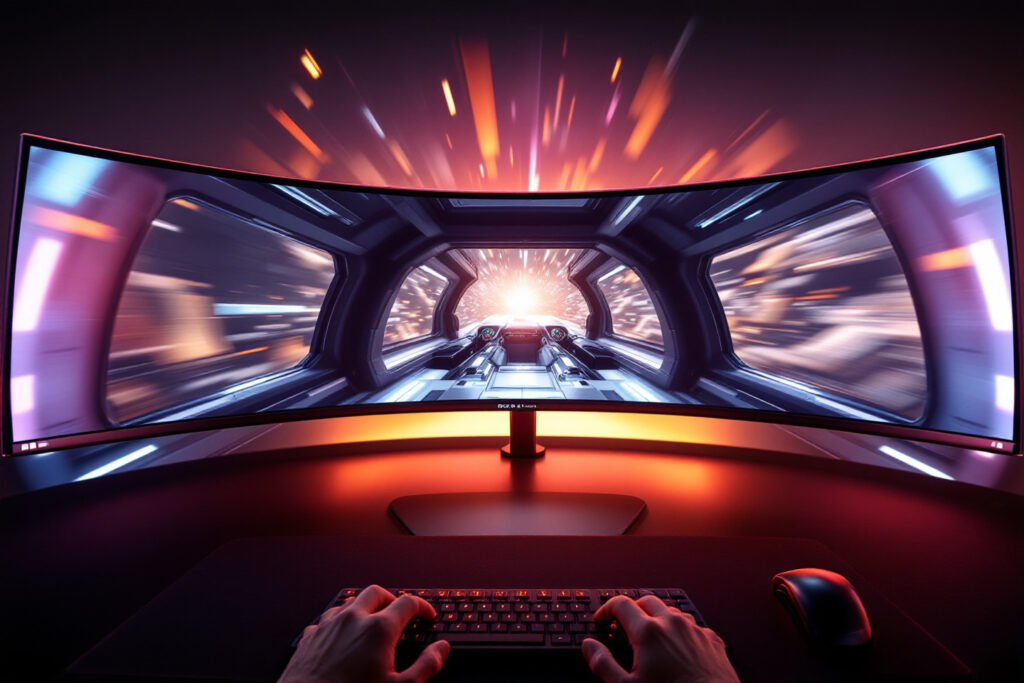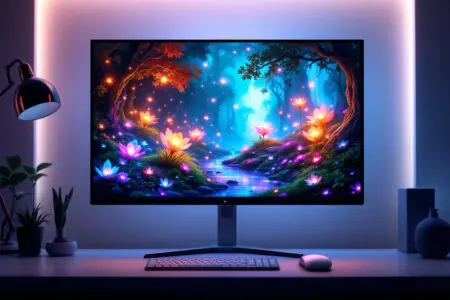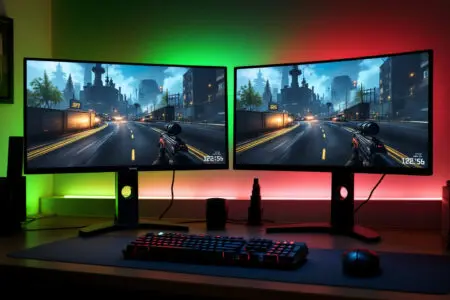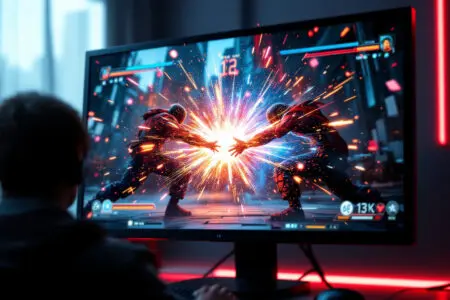You see them in every electronics store. Standing apart from the flat-screen herd, their gentle curve seems to whisper promises of a whole new world of immersion. I’m talking about curved monitors, of course. For the longest time, I was a total skeptic. I wrote them off as a flashy gimmick, something designed to look cool on a desk but offering little real-world benefit. But the question just wouldn’t leave me alone, especially as friend after friend in my gaming group made the switch: Is a curved monitor good for gaming?
That’s the real question, isn’t it? It gets right to the heart of what we, as gamers, want from our gear—total immersion, killer performance, and maybe, just maybe, a leg up on the competition.
This isn’t just about a bent piece of plastic. It’s about how we connect with the virtual worlds we love. Does that arc actually pull you in, or is it just a pricey way to distort the picture? After finally taking the leap myself and logging hundreds of hours, I can tell you it’s not a simple yes or no. The real answer is, “it depends.” It depends on you, the games you play, and what you’re really looking for. Together, we’re going to break it all down, from the science of how your eyes work to the nitty-gritty of panel specs, to figure out if a curved screen is your next essential upgrade or just an overhyped toy.
More in Monitors Category
What is The Best Resolution for Gaming
Key Takeaways
- Immersion is the Main Draw: The whole point of a curved monitor is to mimic the natural curve of your eye. This can create a seriously immersive experience that fills your peripheral vision, especially with bigger, ultrawide models.
- Easier on the Eyes: Because the screen’s edges are slightly closer to you, the whole image stays at a more consistent distance from your eyes. For long gaming marathons, this can mean less eye strain.
- The Competitive Edge is Up for Debate: Some players swear the wider view helps them spot enemies faster. Others don’t notice a difference. It’s a subjective perk, not a guaranteed way to boost your K/D ratio.
- Not for Every Game (or Task): The curve really shines in racing sims, flight sims, and first-person adventure games. For things like graphic design or some strategy games, it can be less helpful or even a little annoying.
- Size and Curve Intensity Matter: A small curved monitor won’t do much. The magic really happens with larger screens that have a more noticeable curve (like 1800R or 1000R). Go big, or you might as well stay flat.
So, What’s the Big Deal with Curved Monitors Anyway?
Before deciding if they’re any good, you have to get what they’re trying to accomplish. It’s not just about looking futuristic on your desk, though that’s part of the appeal. The idea is actually based on biology—the way our own eyes are shaped. We see the world in 3D with a massive field of view. A flat screen is just a flat window. A curved screen tries to be something more.
It’s trying to wrap the game world around you.
How Does the Curve Even Work?
It’s all about maintaining a consistent distance from your eyeballs to the screen. On a flat monitor, the center is physically closer to you than the edges are. Your eyes are constantly, subtly refocusing as they dart from the center to the sides. This can make the image at the far edges seem a little off, almost like you’re looking at it from a weird angle.
A curved monitor simply bends those edges back toward you.
Suddenly, the entire screen is at a more uniform focal distance. The result, in theory, is a more comfortable and natural way to see the image. It’s the same reason IMAX theaters use massive, curved screens—to completely fill your vision and make you feel like you’re part of the action.
Is It Just a Gimmick to Sell More Monitors?
I totally get the skepticism. For the longest time, that was my stance. It felt like the next marketing buzzword, another empty promise to get us to open our wallets. My mind started to change at a buddy’s house. He had just bought a 34-inch ultrawide curved monitor and couldn’t stop talking about it. I sat down to play some Apex Legends, fully prepared to mock it.
“This is going to look so stretched and weird,” I thought.
But it didn’t. Within minutes, my brain just accepted it. The game world felt deeper, wider. The physical edges of the monitor seemed to fade away, and I was just there. It wasn’t some earth-shattering revelation, but it was a real, tangible feeling. The gimmick had substance. My skepticism began to crack.
Does a Curved Screen Really Make Gaming More Immersive?
This is the main event. The big promise. The notion that a piece of hardware can beam you from your desk chair straight into the neon-drenched streets of Night City. Does it deliver? In my experience, absolutely—but it’s not a magic bullet. The sense of immersion is real, creating a “cockpit view” that a flat panel just can’t touch.
Can It Actually Fill Your Peripheral Vision?
It can, and that’s where the secret sauce is. Your peripheral vision is key to feeling present in a space. It’s what tells your brain you’re in a location, not just looking at a picture of it. A flat monitor has hard borders. Your brain is always aware of them. You know, consciously or not, that you are looking at a screen.
A curved ultrawide messes with that perception. By wrapping the image around your field of view, it tricks your brain. The flashes of movement and blurs of scenery at the edges of the game are caught more naturally by your peripheral vision. Your brain starts to believe the game world is bigger than the screen it’s on.
My “Aha” Moment in the Cockpit of an X-Wing
The thing that sold me completely wasn’t a frantic shooter, but a flight sim. I fired up Star Wars: Squadrons on my new 34-inch curved screen for the first time. The second the game loaded and I was sitting in the cockpit of an X-Wing, it all clicked into place. The instrument panels, the holographic readouts, the canopy—it all wrapped around me perfectly.
I could glance at my power management on the left and my radar on the right, and it felt like I was looking at a physical object inside a real cockpit, not just a flat UI element. When I banked hard to dodge laser fire, the massive hull of a Star Destroyer streaked past in my periphery with a sense of speed and scale that felt incredibly real. I had never felt that “in the game” outside of a VR headset. That was it. I finally got it.
Will I Feel Less Eye Strain After a Long Session?
This is one of the more practical benefits, and it’s a big one if you’re prone to marathon gaming sessions. As I mentioned, the curve keeps everything at roughly the same distance from your eyes. Some research supports the idea that this can reduce eye fatigue. The logic, as pointed out in studies related to visual ergonomics like those discussed by Harvard Medical School, is that less focusing effort equals less strain over time.
Speaking from my own experience, I’ve noticed a real difference. After a long night playing Baldur’s Gate 3, which involves a ton of reading and map-scanning, my eyes just feel less fried than they used to with my old flat screen. It’s a subtle but hugely appreciated comfort.
Will a Curved Monitor Give Me a Competitive Edge?
Okay, now we’re getting into controversial territory. Immersion is great, but a lot of gamers are laser-focused on one thing: winning. Can a monitor’s shape actually make you a better player? Will it boost your K/D in Call of Duty? The answer is a big, fat “maybe.”
It won’t make you a pro overnight. But it might help.
Can I Really See Enemies in My Periphery Faster?
Here’s the idea: in a twitchy shooter, information is life. Seeing an opponent a split-second sooner is the difference between victory and the kill-cam. On a curved ultrawide, your field of view is physically wider. An enemy who would have been off-screen on a standard 16:9 monitor might be visible at the very edge of your 21:9 display.
The curve makes that extra screen real estate more useful. Because the edges are angled toward you, your peripheral vision is more likely to pick up on movement without you having to turn your character. You get more information with less effort.
- You literally see more of the map to your left and right.
- Movement at the edges is easier to spot and react to.
The One Time I Thought It Helped Me Clutch a Win in Valorant
I’m no pro, but I take my ranked games seriously. I was in a nail-biting 1v2 on Valorant‘s Haven map. I was defending the C site, knowing one enemy was hiding in a back corner and the other was pushing the long approach. On my old flat monitor, I would’ve had to constantly flick my view between the two spots, leaving me vulnerable.
With my curved ultrawide, I could keep the main entrance centered while still having the back corner visible at the very edge of my screen. I caught the faintest flicker of movement in my periphery—just a few pixels shifting—and snapped to the target for the first kill. That bought me the time to reposition and win the second duel. Did the monitor win that round for me? It’s impossible to say for sure. But it felt like it gave me the critical piece of information I needed to make the play.
What About Strategy Games? Is There a Benefit There?
The advantage isn’t just for shooters. In fact, it can be even bigger in games like StarCraft II or League of Legends. These games are all about map awareness. Being able to see more of the battlefield at a glance is a colossal advantage.
With a curved ultrawide, you can watch a huge team fight erupt in the mid-lane while also keeping an eye on your minimap and the enemy jungler’s approach on the side. It gives you a commanding overview of everything that’s happening, helping you make smarter decisions faster.
But Are There Any Downsides I Should Worry About?
It’s not a perfect technology. Curved monitors have their own quirks and potential frustrations. Before you run out and grab one, you need to know about the potential deal-breakers. For some, these are minor issues; for others, they’re major flaws.
Will Everything Look Weird and Distorted?
The first time you use a curved screen, things can look… funky. Straight lines, like the top of your web browser, can look like they’re bowing inward. Your brain is conditioned to see the world on flat planes, and it takes a day or two to adjust. For most people, this feeling vanishes quickly.
But this slight distortion can be a huge problem for certain work. If you’re a digital artist, photographer, or anyone who needs geometrically perfect straight lines, a curved monitor can be a disaster. The subtle warping makes it incredibly hard to judge perspective correctly. For professional creative work, a high-quality flat monitor is almost always the smarter choice.
What If I Do More Than Just Game on My PC?
Most of us use our PCs for everything. How do curved monitors handle normal, boring stuff? For general work—writing emails, browsing the web—they’re great. The extra horizontal space on an ultrawide is a dream for multitasking.
The main snag is watching videos. A lot of content on Netflix or YouTube is shot in a standard 16:9 format. When you watch it on a 21:9 ultrawide, you’ll get black bars on the sides. It’s not the end of the world, but it feels like you’re not using the whole expensive screen you paid for.
That Time I Fought with Glare From My Window
This was a problem I never saw coming. My desk sits near a window. With my old flat screen, I could just tilt it a bit to kill any reflections. A curved monitor is a different animal. Its concave shape acts like a satellite dish for light, catching reflections from a much wider angle.
It’s a glare magnet.
One sunny afternoon, I was staring at a warped, fun-house mirror version of my window stretched across my game. I had to completely reorganize my desk to fix it. It’s a small thing, but if your room has a lot of bright lights behind your chair, you might be in for a new battle with glare.
Are These Things More Expensive?
Yep, usually. Making a curved screen is just more complicated than making a flat one, and that extra cost gets passed on to you. If you compare two monitors with the same resolution, refresh rate, and panel type, the curved model will almost always be pricier.
The price difference isn’t as massive as it used to be, but it’s still there. You have to decide if the immersive curve is worth the extra cash, or if you’d be better off putting that money toward a faster graphics card instead.
What Should I Look For When Buying a Curved Gaming Monitor?
So, you’ve weighed the pros and cons and decided to join the curve. Awesome. But now you have to pick one, and not all curved monitors are the same. A few key specs make a huge difference in the experience.
Does the Size of the Monitor Matter More with a Curve?
One hundred percent. In my opinion, a curve on a small monitor is almost pointless. On a 24-inch, 16:9 screen, the curve is more of an aesthetic choice than a functional one. The screen just isn’t wide enough for the wrap-around effect to happen.
The curve really starts to make sense at 27 inches and becomes a true game-changer at 32 inches and beyond, especially on ultrawide (21:9) or super ultrawide (32:9) screens. The wider the monitor, the more effective the curve is. If you’re going curved, go big.
What Do Those ‘R’ Numbers Even Mean (1800R, 1000R)?
You’ll see these numbers everywhere: 1800R, 1500R, 1000R. The “R” stands for radius in millimeters, and it tells you how aggressive the curve is. It’s the radius of the circle the monitor would make if it were a complete ring.
- 1800R: A common and fairly gentle curve. It has a radius of 1800mm. It’s noticeable but not extreme.
- 1500R: A tighter, more pronounced curve. This is becoming a popular sweet spot, offering a great sense of immersion.
- 1000R: The most aggressive curve you can buy. It’s designed to perfectly match the curve of the human eye. This offers maximum immersion but can be jarring for some and might make distortion more noticeable.
The right one for you is a matter of personal taste. A tighter curve like 1000R is generally better if you sit closer to your screen.
Panel Types: VA vs. IPS on a Curved Screen
The age-old panel debate continues with curved monitors.
VA Panels: For a long time, most curved monitors used VA panels. They bend well and have one huge advantage: amazing contrast. Blacks are deep and dark, which is incredible for horror games or watching movies. Their downside can be slower response times, which can sometimes cause a bit of ghosting or smearing in very fast-paced games.
IPS Panels: Curved IPS panels are more common now. IPS is known for having fantastic color accuracy and great viewing angles. Their contrast isn’t as good as VA (blacks can look a little gray), but they usually have faster response times, making them a top choice for competitive gamers and content creators.
The Final Verdict: Is a Curved Monitor Good for Your Gaming Setup?
After all is said and done, we’re back where we started. A curved monitor isn’t an automatic win for every gamer out there. It’s a specific piece of tech that is amazing for some people and “meh” for others. It all comes down to what you value most.
Who Is a Curved Monitor Perfect For?
You will probably fall in love with a curved monitor if you’re:
- The Immersion Seeker: If you want to feel like you’re literally inside the game, a big curved ultrawide is the best way to do it short of VR. For single-player adventures and RPGs, it’s a sublime experience.
- The Simulation Fanatic: If you play racing, flight, or space sims, a curved monitor is practically essential. The cockpit view it creates adds a layer of realism you just can’t get from a flat screen.
- The Multitasking Power User: If you need a monitor that can juggle three windows for work and then seamlessly switch to an epic gaming session, the sheer horizontal space of an ultrawide is a game-changer.
Who Might Want to Stick with a Flat Screen?
On the other hand, you might be better off with a traditional flat panel if you’re:
- The Hardcore Competitive Purist: Many pro e-sports players stick with smaller, 24-inch flat screens. Their logic is that they can see the entire screen at a glance without moving their eyes, ensuring the absolute fastest reaction time.
- The Creative Professional: If you’re a graphic designer, video editor, or anyone who needs perfect lines and zero distortion, the curve is more of a hindrance than a help.
- The Budget-Conscious Builder: If every dollar in your PC build counts, the extra cost of a curved monitor is tough to justify. That money would have a bigger impact if spent on a better graphics card.
Choosing a monitor is personal. I went from a total skeptic to a true believer, but that’s just my story. If you can, try one out in person. But if you’re a gamer who puts that feeling of immersion above all else—if you want the game world to pull you in and not let go—then yes. A curved monitor is absolutely good for gaming. It’s a curve worth taking.
FAQ – Is a Curved Monitor Good for Gaming
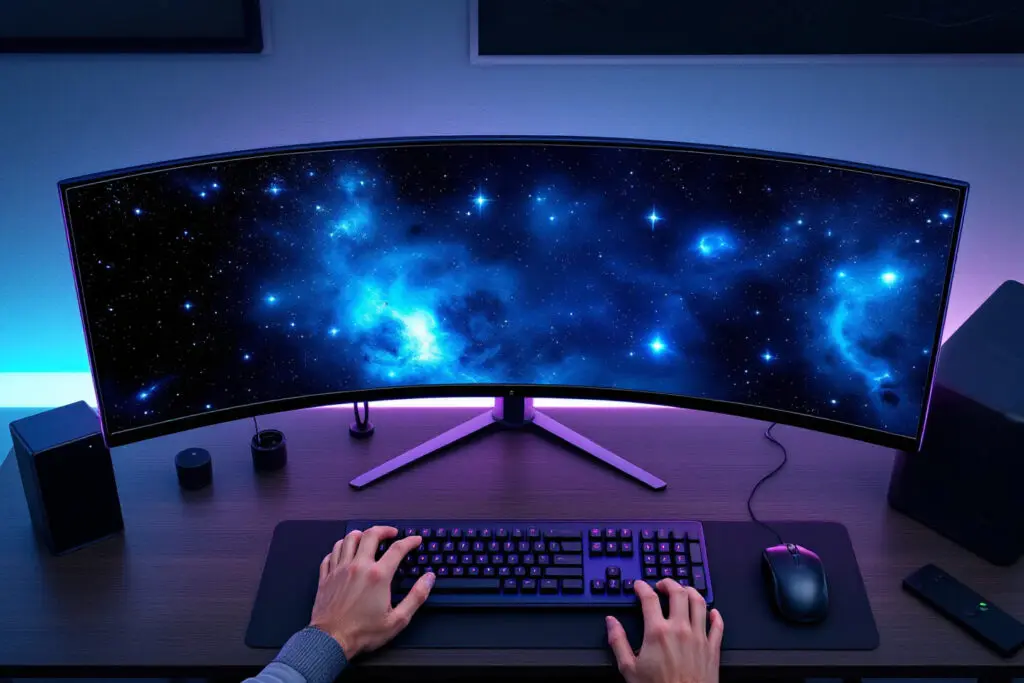
What should I consider when choosing a curved gaming monitor?
Size, the radius of the curve (like 1800R, 1500R, 1000R), panel type (VA or IPS), and whether the monitor suits your specific gaming or multitasking needs are key factors to consider.
What are the downsides of using a curved monitor?
Downsides include potential distortion of straight lines, glare issues from reflections, higher cost, and less effectiveness with standard 16:9 video content, as well as potential difficulties for professional work requiring precise geometry.
Are curved monitors good for competitive gaming?
Curved monitors may offer a competitive edge by providing a wider field of view and making it easier to spot enemies at the edges, although the actual impact varies from player to player.
How does the curve of a monitor improve the gaming experience?
The curve maintains a consistent distance from your eyes across the screen, providing a more natural and comfortable viewing experience that can reduce eye strain and make the game world feel more expansive.

